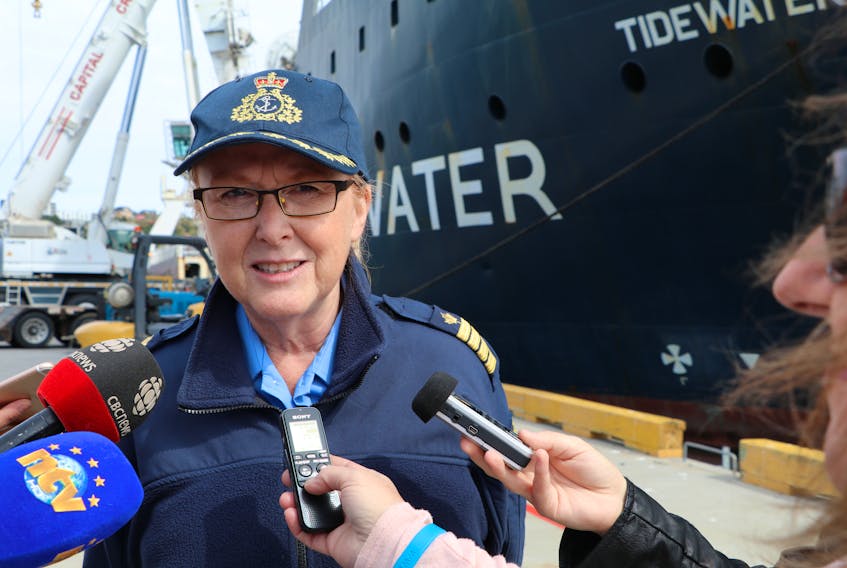ST. JOHN'S, N.L. - There was a jam bottle full of Manolis L recovered crude oil available for members of the media to take a look at Sept. 11 in St. John’s.
It was black and thick, and looked nearly in its pure form as when the tanker sank and took hundreds of tonnes of it down with it near Change Islands in Notre Dame Bay 33 years ago.
Open that jar and touch the oil and it would be difficult to get off your fingers.
For seabirds getting caught in a spill of it on the ocean surface, sticking to their feathers, it would mean the end. A sense of unease had carried through communities in recent years, from house to house and boat to boat — heightened each time someone reported seeing oiled birds or a sheen of oil on the water’s surface.
A citizens’ response committee was formed as worry increased for the wildlife, marine mammals, the environment and the all-important fishing grounds and fish stocks the region relied upon. The committee, backed by local residents and supporters, fought for action.
The effort has culminated this week with a sigh of relief along the coasts like a comforting summer breeze.
Ardent Global LLC., under contract by the Canadian Coast Guard, completed the removal of the oil that was still in the storage tanks of the Manolis L wreck — pumping it from 200 feet below the surface where the wreck had settled after running upon the treacherous Blow Hard Rock during a January storm in 1985.
During the oil removal operation this summer, the Canada Coast Guard and Transport Canada were on the scene monitoring the operation with resources ready to respond should anything go wrong.
Anne Miller, regional director of incident management for the Canadian Coast Guard, Atlantic Region, and who was the incident commander during the Manolis L oil removal operation, reported Tuesday that the oil removal operation was a success.
“We concluded the oil recovery operation at the wreck site over the weekend and we are here today off-loading the recovered oil from the wreck,” Miller said. “We haven’t had the exact amount quantified as of yet. That will be done through the off-loading process and provided to us in the official report from Ardent Global, our salvage company. But preliminary results are that it’s well within the estimated amount that was provided to us by Resolve Marine during the assessment in 2016.
“We are very happy with the outcome and we are confident that the risk of a significant release of pollution from the Manolis L has been eliminated.”
- All oil removed from Manolis L, coast guard tweets
- Work continuing to remove oil from Manolis L wreck
- INTERACTIVE: Manolis L cleanup almost underway in Notre Dame Bay
During a $5-million technical assessment carried out in the summer of 2016 by Resolve Salvage of Fort Lauderdale, Fla., it was discovered that much of the cargo of heavy fuel oils and diesel that was thought to have gone down and remained in the Manolis L had escaped — some of it at the time of the grounding and sinking through ripped-open tanks, while more was released gradually over the years through cracks in the hull.
The Manolis L sailed with 522 tonnes of oils onboard — combining both the diesel and the heavy oils. The amount remaining on board was assessed to be in the range of 113 to 151 tonnes.
In April, the federal government announced that a $15.1-million contract for the removal of bulk oil from the Manolis L shipwreck was awarded to Ardent Global. According to its website, the company is a specialist in emergency preparedness and response, wreck removal and offshore decommissioning. The company gained fame as the one that raised the cruise liner Costa Concordia off the coast of Italy after it rammed into a rocky outcropping in January 2012, an accident that caused the loss of 32 lives.
Ardent Global and the Canadian Coast Guard began work at the Manolis L site in July.
Miller said the oil was removed and the wreck secured.
“Before we left the wreck site we did what we call securing the wreck in salvage terms,” she said. “Any penetrations into the wreck were secured. There were several complete surveys done of it to ensure that any concerns were taken care of, whether it was placing seals on suspected areas and capping the protrusions. But going forward the wreck site will continue to be monitored by Coast Guard patrols or aerial patrols when in the area.”

The recovered oil was pumped from the wreck using ROV technology and contained onboard the Tidewater Enabler, the huge salvage vessel used by Ardent Global as the staging platform for the operation.
At dock in St. John’s harbour Tuesday, Envirosystems Inc. began unloading the “waste oil,” which will be cleaned at the company’s St. John’s facility and then transported to approved combustion facilities in the province.
Envirosystems is a provider of industrial and environmental services that include catalyst changeout, chemical cleaning, dredging, high pressure cleaning, hydro-excavation, mobile spent caustic treatment, waste disposal/treatment and vacuum services.
“We are supporting the main contractor Ardent Global in this,” said Roy Baker, branch manager for Envirosystems in St. John’s.
“Our facility in St. John’s will be the initial receiving site for the waste oil from the Manolis L, and our company is removing the oil from the Tidewater Enabler vessel, and it will be transported to our facility on Logy Bay Road.
“Once the waste oil is received it is processed at our facility. It’s a thermal, mechanical, chemical treatment process which is used to de-water the waste oil and remove the salt and sediments. Once it comes out of our process, it’s transported to approved used-oil combustion facilities within the province.”
Miller noted that during the work the team did in Notre Dame Bay, the people of the area were welcoming and supportive.
“It was a pleasure (to deal with the local people), the reaction and the welcoming we got from the people in the Twillingate area was second to none,” Miller said. “It definitely made all of our crews, our personnel and our partners that were assisting us very welcome. All a positive experience. And I’d like to thank the local people of the Twillingate area for their support during the last two months.”
Carolyn Parsons, co-chair of the Manolis L Citizens Response Committee, said people all across the province are “so happy” after five years of battle.
“I cried when they had all the oil out. We knew it was coming, but it was a huge relief that it was gone,” Parsons said. “It was a long haul and a lot of work and a lot of time, but we stuck it out.”
Parsons said money left over from fundraising will be used to “pay it forward” to environmental groups that helped the committee.
“We were able to give the Newfoundland and Labrador Environmental Network more than $2,600 and the East Coast Environmental Law Association more than $6,000 to be used for initiatives within the province of Newfoundland and Labrador.”
The money was raised through art shows, a concert, a march and donations from people and organizations around the province.
Parsons said there is only one more matter for the committee to take care of.
“We have one more motion to make,” she said. “To dissolve the committee and we are doing that in October.”
Full coverage:
- All oil removed from Manolis L, coast guard tweets
- Work continuing to remove oil from Manolis L wreck
- INTERACTIVE: Manolis L cleanup almost underway in Notre Dame Bay
- IN DEPTH: Oil to be removed from Manolis this summer
- Coast guard survey of Manolis L finds no oil
- Contract awarded for oil removal from Manolis L near Change Islands, N.L.
- Coast Guard removes 500 litres of fuel from Manolis L site (2017)









